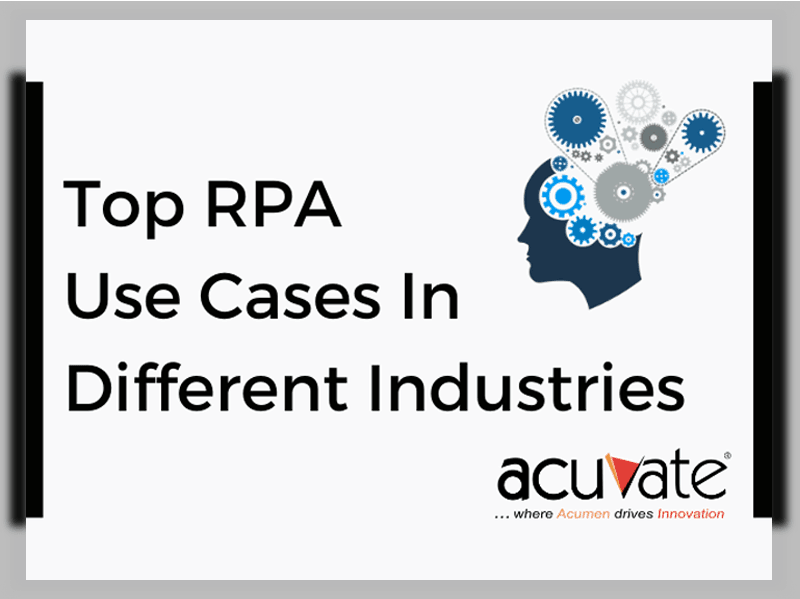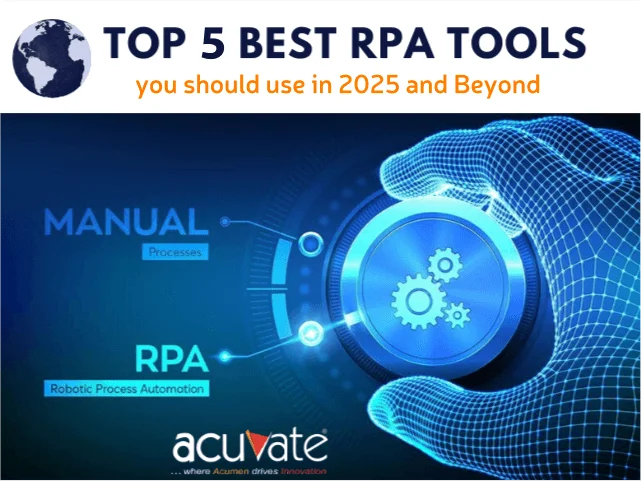Current businesses and technologies go hand in hand. And as businesses continue to evolve and adapt to the digital age, the demand for efficient and streamlined processes has turned out to be greater than ever.
Robotic Process Automation (RPA) has emerged as a game-changing technology, revolutionizing the way organizations automate their workflows. 83% of IT leaders believe workflow automation is highly required for a digital transformation.
But what does the future hold for workflow automation?
In this blog, we will explore the emerging trends and technologies that are shaping the landscape of RPA workflow automation and intelligent automation. From advanced analytics and artificial intelligence to low-code platforms and process mining, these innovations are set to drive productivity, enhance operational efficiency, and empower businesses to thrive in the digital era.
The Power of RPA in Workflow Automation
RPA has gained significant traction in recent years due to its ability to automate monotonous, and redundant tasks. Organizations can streamline their workflows, eliminate human errors, and increase operational efficiency, by leveraging robots. RPA helps businesses automate an array of processes. This includes tasks such as data entry, document processing, invoice management, customer service, and other business process management. Therefore, employees are free to focus on more strategic and value-added activities, driving innovation and growth. The future of workflow automation heavily relies on the continued advancement and adoption of RPA technologies.
Embracing Intelligent Automation for Complex Workflows
While RPA is highly effective for automating repetitive tasks, complex workflows often require a more advanced solution. Intelligent Automation combines RPA with Artificial Intelligence (AI) and Machine Learning (ML) capabilities can help in handling unstructured data, making data-driven decisions, and performing cognitive tasks.
Such a promising .combination enables businesses to automate complex processes that involve multiple processes. These processes include data extraction, natural language processing, sentiment analysis, and decision-making. Intelligent Automation equips organizations to achieve greater accuracy, adaptability, and scalability in their workflows, unlocking new levels of efficiency and productivity.
Advanced Analytics for Data-driven Workflow Optimization
Data-driven insights play a crucial role in optimizing workflows. Advanced analytics, including processes such as mining and predictive analytics, are revolutionizing how organizations analyze and improve their processes. Process mining allows businesses to visualize and understand their workflows, identify bottlenecks, and uncover inefficiencies. By analyzing real-time data, organizations can identify patterns, anticipate process deviations, and proactively take corrective actions.
Predictive analytics leverages historical data and algorithms to forecast future process performance, enabling businesses to make informed decisions and continuously optimize their workflows.
Low-code Platforms Empowering Citizen Developers
Conventionally developing and implementing automation workflows required significant programming skills. However, low-code platforms are changing the game by empowering individuals without extensive coding knowledge to build and deploy automated workflows, tools, and apps.
Low-code platforms provide a visual interface and pre-built components, allowing users to design, test, and deploy automation workflows with minimal coding effort. This democratization of automation enables organizations to accelerate the development cycle, increase agility, and leverage the creativity of non-technical users. As the adoption of low-code platforms grows, the future of workflow automation will witness a surge in automation initiatives across various departments and roles within organizations.
For example, MS power automate can substantially help users with capabilities such as:
- Seamless collaborations
- Customized workflows
- Mobile-first productivity
- Enhanced visualizations
- Data connectivity
- Advanced analytics
- Real-time monitoring and alerts
- Data security and compliance
Collaborative Robots and Human-Machine Collaboration
The future of workflow automation goes beyond replacing humans with robots. Collaborative robots, also known as cobots, are designed to work alongside humans, enhancing collaboration, productivity, accuracy, and efficiency. Cobots can handle tasks that require physical interaction, such as assembly or quality control, while humans focus on complex decision-making and problem-solving. This human-machine collaboration not only optimizes workflows but also improves job satisfaction and creates a harmonious work environment. The rise of cobots signifies a future where humans and robots work hand-in-hand, leveraging their respective strengths to drive innovation and productivity.
Hyperautomation: The Convergence of Technologies
Hyperautomation is an emerging trend that combines multiple technologies, including RPA, AI, ML, and process orchestration, to achieve end-to-end automation across the entire business ecosystem. This approach seeks to automate not only individual tasks but entire processes, connecting disparate systems, and orchestrating complex workflows.
Hyperautomation leverages AI and ML algorithms to learn from data, adapt to changing conditions, and make intelligent decisions in real time. By integrating various technologies into a cohesive automation strategy, organizations can achieve unprecedented levels of efficiency, agility, and scalability in their workflows.
Intelligent Document Processing (IDP)
Managing and processing vast amounts of documents is a common challenge for many businesses. Intelligent Document Processing (IDP) combines RPA with AI-powered Optical Character Recognition (OCR) and Natural Language Processing (NLP) capabilities to automate document-centric processes. IDP can accurately extract data from structured and unstructured documents, such as invoices, contracts, and forms, reducing manual effort and improving data accuracy. This technology not only accelerates document processing but also minimizes the risk of errors, ensuring compliance and enhancing overall productivity.
The Role of Human-Centered Design
While intelligent automation technologies offer tremendous benefits, it is crucial to remember the importance of a human-centered approach. The future of workflow automation lies in designing solutions that enhance the employee experience, rather than replacing humans entirely. By involving employees in the automation design process and considering their needs and feedback, organizations can create workflows that optimize human-robot collaboration, streamline tasks, introduce an additional layer of security, and foster a positive work environment. The human-centered design ensures that intelligent automation technologies empower employees, allowing them to focus on higher-value work that requires creativity, critical thinking, and emotional intelligence.
The way forward
The future of workflow automation is poised to bring significant advancements and transformative changes to organizations worldwide.
The convergence of technologies such as RPA, AI, ML, and process orchestration will drive hyper-automation, enabling end-to-end automation across the business ecosystem. Intelligent Document Processing (IDP) and Workflow Automation will streamline document-centric processes leading them to be more precise in their results, thereby creating more scalable automation solutions.
Moreover, the human-centered approach ensures that automation technologies empower employees and foster collaboration between humans and machines. As organizations continue to embrace these emerging trends and technologies, they unlock unprecedented levels of operational efficiency, productivity, and agility. The future of workflow automation is bright, and the organizations that are swift in embracing it will be better equipped to navigate the complexities of the digital era and achieve sustainable success in the times to come.
The future of workflow automation is dynamic and filled with opportunities for organizations across industries. With the advancements in RPA, intelligent automation, advanced analytics, low-code platforms, collaborative robots, and hyper-automation, businesses can achieve unprecedented levels of operational efficiency, productivity, and agility.
As organizations embrace these emerging trends and technologies, it is crucial to maintain a human-centric approach, ensuring that automation enhances the employee experience and fosters collaboration between humans and machines. The advancements in technology are sure to make it a complementary force to the human potential.
By harnessing the power of workflow automation, organizations can revolutionize their processes, drive innovation, and position themselves for success in the digital age.



